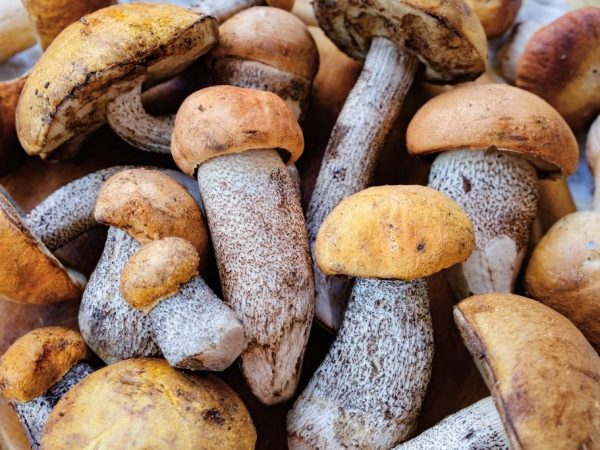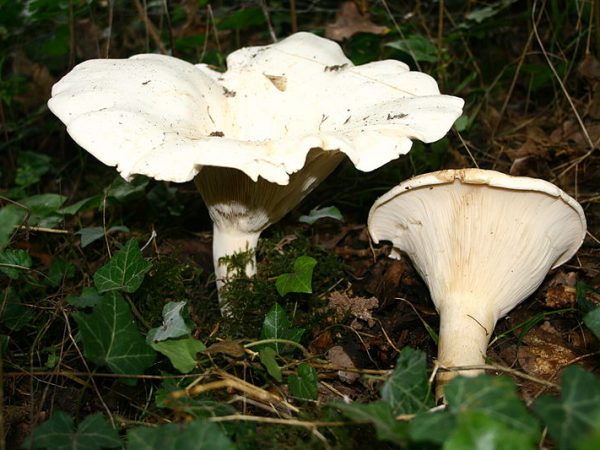Mushroom picking in Crimea
The expanses of Crimea are distinguished by rich vegetation and fertile soil. The best mushrooms of Crimea grow in mountainous areas at an altitude of 200-700 m, in forests, in the steppe zone and on the plateaus of the peninsula.

Mushroom picking in Crimea
Description of the mushroom site
Mushrooms in Crimea can be found at the Ai-Petrinskaya Yayla. A rich harvest is given by the forests in Luchisty in the region of Mount Demerdzhi.
A quiet hunt in the Bakhchisarai forests will be successful. In the East, mushroom places are located in Feodosia. Crimean mushroom pickers harvest in the steppe zone in the Donuzlav and Sasyk estuaries. For mice they go to the village of Kolchugino and to the area of the astrophysical observatory. They go to the villages of Zelenogorskoye and Stroganovka for boletus.
Camelina is hunted near the village of Rybachye, and chanterelles are hunted in the village of Mramorny.
Time of appearance
Crimean edible mushrooms are harvested all year round. It all depends on the weather conditions. Mushroom pickers go hunting after a downpour, after 3 days, when clear warm weather sets in. During this period of time, mycorrhiza develops. Spores located on the roots of trees and the upper layers of the soil quickly produce mycelium filaments and spread to neighboring areas.
The favorable temperature for the development of mycelium is 18-20 ℃. Going for the gifts of the forest in cold weather, you will be left without a catch.
Description of the region's mushrooms
The best edible mushrooms are collected in Crimea: chanterelles, saffron milk caps, boletus, Crimean white mushroom, mice, raincoat, one-barrel.
In addition to edible ones, there are also poisonous Crimean mushrooms: false mushrooms, pale toadstools, fly agarics. When harvesting, do not rush to put the whole family in the basket, carefully check the "catch". Poisonous specimens grow singly.
Chanterelles
Steppe mushrooms of Crimea are represented by chanterelles. They have 2 differences: lack of worminess and "one-piece" structure. A hat with a leg is a single whole. It is similar in shape to a lily. The cap has a size of 5-12 cm. The top surface of the cap is smooth.
The pulp is dense, elastic. Closer to the yellow leg. When pressed, it becomes reddish. The leg is uniform, smooth, tapering downward. The hymenophore is folded. Chanterelles grow in groups.
Irina Selyutina (Biologist):
Among fans of mushroom hunting, chanterelles are valued not only for their excellent taste, but also for the fact that insect larvae (or, more commonly, worms) are almost completely absent in their fruit bodies. This is due to a special compound - chinomannose, which is a natural shield of the fungus from parasites seeking to feast on its pulp.
The harvest season begins in May after thunderstorms and continues until September.
Ryzhiki
They are considered one of the most delicious representatives of the mushroom kingdom. Found in clearings of coniferous forests. They do not grow alone, but they do not ripen at the same time. They are usually located on the north side of the trees. In a mature specimen, the cap reaches 15 cm. The color is from light yellow to bright orange.
Representatives with a reddish or blue-green cap are rare. The pulp gives off a yellow milky juice, thick in structure and sweet in taste. The surface of the cap is sticky and smooth. The pulp on the cut is orange, in reaction with atmospheric oxygen it becomes green.
The height of the leg is 7-9 cm. Inside it is hollow, cylindrical in shape. The leg is fragile and easily crumbles when pressed. The smell is weak, the taste is slightly bitter. Mass ripening begins in July and continues to bear fruit until October.
Butterlets
The hat is hemispherical or conical. In the diametral plane, it reaches 15 cm in adult specimens, 4-5 in young specimens. The main distinguishing feature of butter oil is a thin brown skin covered with oily mucus, which heavily pollutes the pickers' hands.
The hymenophore is tubular. The tubules are adherent, light yellow in color. The pulp is firm, soft. On the cut, it turns red or blue. You need to collect them quickly, because representatives of this genus age in just a week and become wormy.
The leg is cylindrical, 4-10 cm high. Painted white. Mushroom families appear in the middle of summer. They grow singly, in small groups. Collection of butter oil continues until November.
Crimean mountain porcini mushrooms (giant talker)
Crimean mountain porcini mushrooms are considered the most delicious variety, extremely valuable. The cap is convex or funnel-shaped, the diameter varies within 20 cm. The color is white-cream, the edges are cracked. The surface of the cap is smooth.

Giant talker
They have a dense cap, secrete transparent juice. In the old representative, the pulp becomes fibrous, turns yellow. The leg is small in relation to the size of the cap and its length is 3-8 cm. It is thickened from below, from above it is covered with villi.
The main value lies in the ability to produce the antibiotic clitocybin, which destroys tuberculosis bacillus. Mushroom sites are located near mountain ranges. Edible white mushroom in Crimea appears in May after thunderstorms, bears fruit until September-October.
Mice
Edible representatives that got their name from their color. In another way, they are called ryadovki. The hat resembles an umbrella in shape, its diameter is 3-20 cm. The leg is elongated, up to 13 cm, white. You can collect them on slopes, in forests, mossy areas.
The skin on the cap is dry. The hymenophore is lamellar, white. The richest mushroom places are located in a forest area near the village of Kolchugino, near the village of Nauchny, and near the village of Zhuravushka.
Raincoat
Belonged to the Champignon family. The body is round. The cuticle fits snugly against the cap. As it matures, voids form inside, in which spore powder is located.
These species form mycelium in forests and meadows. Types of raincoats: giant, prickly, bighead, oblong.
The raincoat is highly valued in medicine. Spore powder is a good styptic. Only young specimens with white elastic, dense pulp are eaten. The picking season starts in May. Autumn raincoats are highly prized for their medicinal properties.
Single barrel
Belongs to the category of field and steppe. Mushroom pickers call the variety - steppe oyster mushrooms. The one-barrel grows in the steppes, on which there are no trees. Outwardly, this representative resembles a lopsided funnel, wrapped to the edge. For the development of mycelium, spores need herbaceous plants.
Irina Selyutina (Biologist):
The single-barrel steppe or, as it is often called, the southern chanterelle is found in dry steppe, mountain-steppe or semi-desert areas, in pastures and wastelands, although it belongs to the Oyster family. Here it settles on the stems of umbrella plants, for example, resinous or tartar. Mushrooms often grow in groups, sometimes it happens that the legs of 2-3 specimens grow together. Most Crimean mushroom pickers call them steppe oyster mushrooms.
The diameter of the cap is 4-30 cm, the body is compacted, fleshy.The surface is smooth or slightly scaly. The color is off-white or gray-red. The plates are rare, wide. The pulp is dense, fibrous, has a mild interesting taste, exudes a pleasant, but barely noticeable mushroom aroma.
The leg is 3-5 cm, compacted, tapers towards the base. Inside, the legs of the old mushroom bodies are similar in structure to cotton wool. Fruiting in March-June and September-January. Among oyster mushrooms, autumn one-barrels are considered the most valuable variety in terms of taste. To gather a rich harvest, focusing on the map, look for fields and meadows with abundant forbs.
False heap
There are several types of false hornets.
- Sulfur yellow: small poisonous representative, the cap of which is painted in a light yellow color. In the central part, the cap is darker than at the edges. The lamellar parts are green. It grows in deciduous forests, rarely found in conifers.
- Poppy: quite edible, outwardly reminiscent of the summer varieties of honey agarics. The color of the hat depends entirely on the level of humidity: the higher this indicator, the darker the hat.
- Brick Red: conditionally edible. It has a strong bitterness in its raw form, therefore it requires a long cooking. It differs from ordinary mushrooms in size. The hat is 10 cm, convex, thickens as it grows, is colored red-brown. Often forms large clusters. Saprotroph, settles on dead deciduous tree trunks.
- Watery: not edible. Young mushroom bodies have a bell-shaped cap. The color variety depends on the humidity level.
- Candolle: conditionally edible. The cap is bell-shaped; in an adult specimen it becomes flattened. The color is almost white or yellowish brown.
False heaps are almost no danger to humans. The only poisonous specimen is sulfur-yellow honey fungus. This honey mushroom is distinguished by the presence of a "skirt" on the leg. If it is not there, it is better to refuse to collect such copies.
Death cap
The pale toadstool is disguised as champignons. It is especially difficult to distinguish it from an edible specimen at a young age. The old toadstool is easier to spot. The main feature is the presence of rings under the cap and a bag formed from the remains of a common bedspread.
The hat is convex in the center. It is dyed in a pale olive color. The pulp has an unpleasant pungent odor. The poison is deadly. The fruiting season occurs in parallel with the edible varieties.
Fly agaric
Crimean mushrooms have fly agarics in their arsenal. The color of the cap depends on the variety. They can be red, yellow, white, green and orange. Amanita species found in Crimea: red, smelly, royal, Caesar (edible variety).
Mushroom bodies are large, fleshy. Young fly agarics are distinguished by a domed hat. The skirt is located on the leg expanding from top to bottom in the upper part. They belong to the hallucinogenic species. Signs of poisoning appear 15 minutes after consuming the product.
Conclusion
The collection of edible mushrooms in Crimea continues all year round, due to the climatic conditions of the region. They grow in forest, steppe and mountainous areas. The yield directly depends on the weather conditions. The first representatives begin to appear at a temperature of 18-20 ℃, after heavy rainfall. The most poisonous mushrooms of Crimea are the pale toadstool and the red fly agaric. The names and descriptions of the poisonous mushrooms are a must if you plan to pick mushrooms.


